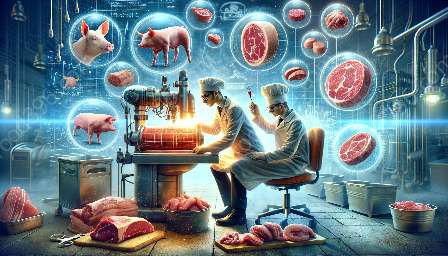Meat preservation has been a fundamental practice for centuries, allowing societies to store and consume meat over extended periods of time. In this comprehensive guide, we will delve into the various techniques of meat preservation, the science behind them, and their compatibility with meat processing. We will explore the impact of preservation methods on meat quality, safety, and consumer preferences, while also addressing the advancements in meat science that continue to drive innovation in the meat preservation industry.
Understanding Meat Preservation
Meat preservation encompasses a range of methods aimed at prolonging the shelf life of meat products and retaining their nutritional value, flavor, and texture. The main objectives of meat preservation include inhibiting microbial growth, preventing oxidative rancidity, and reducing enzymatic spoilage. From ancient techniques such as drying and salting to modern technologies like vacuum packaging and irradiation, the preservation of meat has evolved significantly.
Curing and Salting
Curing is one of the oldest methods of meat preservation and is still widely used today. It involves the addition of curing agents such as salt, sugar, and nitrates/nitrites to meat, which inhibits the growth of spoilage bacteria and enhances the flavor and color of the meat. The process of salting involves covering the meat with dry salt or submerging it in a strong brine solution, effectively drawing out moisture and creating an inhospitable environment for bacteria.
Smoking
Smoking is a preservation method that not only imparts a distinct flavor to the meat but also inhibits microbial growth and helps in dehydration. The smoke from burning wood contains compounds that have antimicrobial properties, making it an effective method for preserving meat while enhancing its taste and aroma.
Freezing and Refrigeration
Freezing meat is a simple yet highly effective preservation method that involves lowering the temperature of the meat to below its freezing point, thereby slowing down enzymatic and microbial activities. Refrigeration also helps in preserving meat by keeping it at a low temperature, inhibiting the growth of microorganisms and delaying spoilage.
Meat Processing and Preservation
Meat processing, a crucial step in the production of various meat products, has a close relationship with preservation techniques. Whether it is the production of cured meats, sausages, or ready-to-eat meals, the preservation of meat plays a pivotal role in ensuring the safety and quality of the final products.
Cured Meats
Curing is an integral part of the production of various cured meats such as bacon, ham, and salami. The combination of curing agents and specific processing methods not only extends the shelf life of these products but also imparts unique flavors and textures desired by consumers.
Sausage Production
When it comes to sausage production, preservation techniques like smoking, curing, and fermentation are commonly utilized to ensure the safety and shelf stability of the final products. These methods also contribute to the characteristic flavors and textures associated with different types of sausages.
Ready-to-Eat Meals
Modern meat processing facilities often integrate preservation techniques into the production of ready-to-eat meals, ensuring that the cooked or processed meat products maintain their quality and safety throughout their shelf life.
The Science of Meat Preservation
Meat preservation is deeply rooted in meat science, which involves the study of the physical, chemical, and biological properties of meat. Understanding the scientific principles behind preservation methods enables researchers and industry professionals to develop innovative techniques for better preserving meat while maintaining its sensory and nutritive qualities.
Microbial Control
The science of preserving meat revolves around understanding and controlling microbial activity. Techniques such as curing, smoking, and packaging are designed to inhibit the growth of harmful bacteria and other microorganisms that can lead to foodborne illnesses and spoilage.
Oxidative Stability
Oxidative rancidity is a common issue in meat products, leading to off-flavors and deterioration of quality. Meat science explores methods to improve the oxidative stability of meat through the use of antioxidants, modified atmosphere packaging, and other innovative approaches.
Consumer Preferences and Safety
Meat science also focuses on understanding consumer preferences and ensuring the safety of preserved meat products. Through sensory analysis and research on food safety, scientists work to develop preservation methods that align with consumer expectations while meeting rigorous safety standards.
Advancements in Meat Preservation
As advancements in technology and food science continue to drive innovation, the field of meat preservation has witnessed significant developments in recent years. From novel preservation techniques to sustainable packaging solutions, the industry is continuously evolving to meet the demands of consumers and address global challenges related to food security and sustainability.
Emerging Preservation Technologies
New preservation technologies such as high-pressure processing, pulsed electric field processing, and natural antimicrobial compounds are being explored to enhance the shelf life and safety of meat products while minimizing the use of traditional preservatives.
Sustainable Packaging Solutions
The focus on environmental sustainability has led to the development of sustainable packaging solutions for preserved meat products. Biodegradable packaging materials and intelligent packaging systems that monitor product freshness are being integrated into the meat preservation process.
Smart Preservation Practices
With the advent of smart technologies and data-driven systems, meat preservation practices are becoming more efficient and precise. Automated monitoring of temperature, humidity, and other environmental factors in storage facilities is enabling better control over meat preservation conditions.
Conclusion
Meat preservation stands at the intersection of tradition, science, and innovation, playing a pivotal role in meeting the global demand for safe, high-quality meat products. By understanding the various preservation methods, their compatibility with meat processing, and the scientific principles that underpin them, we can appreciate the art and science of preserving meat while ensuring its availability and enjoyment for generations to come.

